New Trends in Production and Operations Management
A special issue of Applied Sciences (ISSN 2076-3417). This special issue belongs to the section "Applied Industrial Technologies".
Deadline for manuscript submissions: closed (30 June 2023) | Viewed by 27922
Special Issue Editor
Interests: reliability analysis; machinery maintenance; overall equipment effectiveness; industrial automation; maintenance management; production/operations management
Special Issues, Collections and Topics in MDPI journals
Special Issue Information
Dear Colleagues,
The scope of this Special Issue on “New Trends in Production and Operations Management” is to provide scientific research on issues that are related to the interests and concerns of managers that manage the operations, design and supply chains of products and processes. This includes all subjects in the operations, design, and supply chain management of products and processes, i.e., contribution of performance measurement to operations and supply chain management, sustainable operations, maintenance management, risk management and resilience, logistics, quality management, reliability analysis, lean management, manufacturing and service operations management, strategic management, supply chain management, etc. Moreover, we encourage papers utilizing all research paradigms, as well as case studies.
Prof. Dr. Panagiotis Tsarouhas
Guest Editor
Manuscript Submission Information
Manuscripts should be submitted online at www.mdpi.com by registering and logging in to this website. Once you are registered, click here to go to the submission form. Manuscripts can be submitted until the deadline. All submissions that pass pre-check are peer-reviewed. Accepted papers will be published continuously in the journal (as soon as accepted) and will be listed together on the special issue website. Research articles, review articles as well as short communications are invited. For planned papers, a title and short abstract (about 100 words) can be sent to the Editorial Office for announcement on this website.
Submitted manuscripts should not have been published previously, nor be under consideration for publication elsewhere (except conference proceedings papers). All manuscripts are thoroughly refereed through a single-blind peer-review process. A guide for authors and other relevant information for submission of manuscripts is available on the Instructions for Authors page. Applied Sciences is an international peer-reviewed open access semimonthly journal published by MDPI.
Please visit the Instructions for Authors page before submitting a manuscript. The Article Processing Charge (APC) for publication in this open access journal is 2400 CHF (Swiss Francs). Submitted papers should be well formatted and use good English. Authors may use MDPI's English editing service prior to publication or during author revisions.
Keywords
- performance evaluation
- engineering and manufacturing
- maintenance
- reliability
- supply management
- logistics
- quality
- information systems
- operations management






